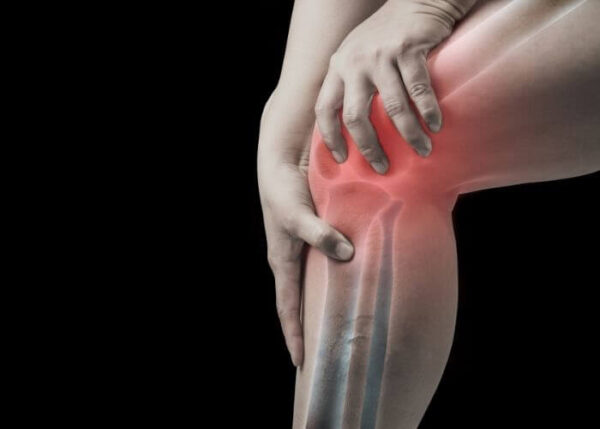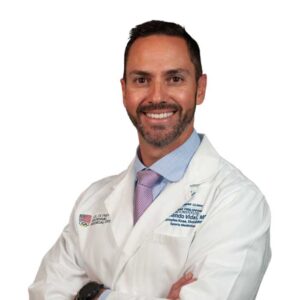What is Osteochondritis Dissecans of the knee?
Osteochondritis Dissecans, or OCD, is a condition that is unique to the growing skeleton. It has been described in the medical literature for over 100 years but despite that – there is still a lot that is unknown about this condition. The name Osteochondritis Dissecans is an old term that literally translates into a “drying out of the bone and cartilage.” It is a condition that affects the subchondral (deep to the cartilage) bone and in extreme cases can cause failure of the cartilage/bone unit. The knee is the most common joint affected, but it can affect almost any joint in the body. This most commonly affects the knees of very active kids that participate in high impact sports.
Patients in Vail, Aspen and the surrounding Denver, Colorado communities can be successfully treated for OCD of the knee by Dr. Armando Vidal, pediatric orthopedic knee specialist.

What causes OCD?
Dr. Vidal and many other pediatric orthopedic sports medicine specialists believe that OCD is caused by repeated stress to the bone. Young athletes who have been involved with competitive sports at an early have been shown to have symptoms of OCD. Constant stress on the femur of developing children can case juvenile osteochondritis dissecans of the knee. In general, the repetitive stress is thought to reduce the blood flow to the bone, causing the attached cartilage to separate from the bone.
What are the symptoms of OCD of the knee?
Pain is the most common complaint. Very frequently, kids have had pain for months or even years that has been diagnosed as “growing pains”. In later stages, swelling and mechanical symptoms can result as well. Oftentimes, parents or coaches will observe that an athlete is limping well before they ever complain of pain.
How is OCD diagnosed?
Dr. Vidal will conduct a thorough medical history, as well as a physical examination of the knee. These lesions can often be seen on plain X-Ray, but MRI remains the gold standard for diagnosis and staging of these lesions.
How is Osteochondritis Dissecans of the knee treated for pediatric patients?
The treatment of OCD depends on two factors – the skeletal maturity of the patient and the stability of the lesion. Both of these require imaging to adequately assess.
Non-surgical Treatments:
Stable lesions in skeletally immature athletes can be treated successfully without surgery if you catch it early enough. Non-surgical management requires activity modification, cessation of both organized sports and free play and use of unloading braces. Typically, it will take a stable OCD lesion 3-4 months to heal with this approach. If caught early enough, this strategy has an established track record of success – however some do not heal and require surgery.
Surgical Treatments:
Surgical management is reserved for the following scenarios:
- Failure of non-surgical management in a stable lesion
- Unstable lesions at any age
- Stable or unstable lesions in kids who are skeletally mature or reaching maturity
- In some cases, surgery will be discussed for high risk stable lesions in skeletally immature athletes. Specifically, chronic lesions and/or large or atypical lesions maybe candidates for more aggressive management.
- Depending on the characteristics of the lesion there are several surgical options available.
They range from:
Drilling: For stable lesions that require surgery (failed non-op and high risk), holes may be drilled into the lesion to encourage bleeding and healing. This technique is very low risk, minimally invasive and works by creating pathways for new blood vessels to nourish the affected area.
Internal fixation: Unfortunately, unstable lesions require stability and drilling alone is not successful in this context. In this scenario, a small incision is made and the base of the lesion is drilled and scar tissue is removed and the OCD fragment is fixed typically with metal screws. This technique is very successful but often requires a second surgery for hardware removal.
Debridement: In some cases, the OCD fragment is not viable or salvageable or it has failed previous fixation. In these cases, the fragment can be removed. Amazingly, kids have such robust healing responses that they can regenerate cartilage in this area without the need for a graft.
Osteochondral Allograft (OCA): In some cases, a graft is required to reconstruct the cartilage/bone unit that is injured. The most successful technique for this is an Osteochondral Allograft. This is an established procedure with decades of success and can be a very long lasting and durable repair when needed.
Cartilage repair is one of the most challenging and nuanced repairs performed by orthopedic surgeons. Dr. Vidal has extensive experience in the management of these injuries and in complex reconstructions.
How long does it take to recover from OCD treatment?
Depending on the severity of the child’s Osteochondritis Dissecans and the type of treatment plan, recovery times can vary between 3 months to a year.
Can my child return to competitive sports after OCD treatment?
Treatment of OCD is more successful in children and adolescents than in adults. Depending on the severity of Osteochondritis Dissecans and the body’s healing capability, most children can return to the sport they love with Dr. Vidal’s help. Physical therapy and even body modification exercises to reduce the stress placed on the knee may be required. It is important to seek the help of a qualified pediatric orthopedic sports medicine team and articular cartilage expert for your child’s best possible outcome.
Osteochondritis Dissecans Surgeon
Osteochondritis dissecans is a condition that only affects patients which are still growing. This condition can cause the joints, especially the knee joint, to fail, so it is extremely important to see a professional if you believe your child is suffering from osteochondritis dissecans. Pediatric knee surgeon, Doctor Armando Vidal provides diagnosis as well as specialized treatment plans for young patients in Vail, Aspen, and the surrounding Denver, Colorado communities who are experiencing difficulty associated with osteochondritis dissecans. Contact Dr. Vidal’s team today!

Locations
180 S Frontage Rd W
Vail, CO 81657
226 Lusher Court
Ste 101
Frisco, CO 80443
322 Beard Creek Road
Edwards, CO 81632


